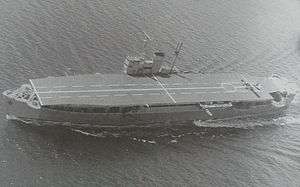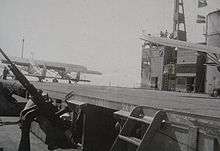Japanese aircraft carrier Akitsu Maru
 Akitsu Maru in 1944 | |
| History | |
|---|---|
| Name: | Akitsu Maru |
| Builder: | Harima, Harima[1] |
| Completed: | January 1942 |
| Fate: | Sunk 15 November 1944 |
| General characteristics | |
| Type: | Aircraft carrier |
| Displacement: | 11,800 tons (standard)[1] |
| Length: | 471 ft 7 in (143.74 m) (pp)[1] |
| Beam: | 64 ft (20 m)[1] |
| Draft: | 25 ft 9 in (7.85 m) (maximum)[1] |
| Propulsion: |
|
| Speed: | 20 knots (37 km/h)[1] |
| Armament: | |
| Aircraft carried: |
|
Akitsu Maru (あきつ丸) was a Japanese landing craft depot ship and escort aircraft carrier operated by the Imperial Japanese Army (IJA). In some sources Akitsu Maru and her sister ship Nigitsu Maru (にぎつ丸) are also considered to be the first amphibious assault ships. Contrary to many secondary sources, the Nigitsu Maru was not fitted with a flight deck.
Design features
Akitsu Maru was a passenger liner taken over before completion by the Imperial Japanese Army. The ship was fitted with a flight deck above the hull, but had no hangar so the aircraft were stored below the flight deck on the original main deck. Conventional aircraft were able to fly off from her deck but could not land aboard due to the short deck length and lack of landing mechanisms. Although, in July 1944, KX arresting gear was fitted on the flight deck. The Kokusai Ki-76 and Kayaba Ka-1 were flown off Akitsu Maru, as the former was a small, slow aircraft that could land on its short deck and the latter was an autogyro which could even more easily land on a short deck without assistance. She could also carry 27 Daihatsu-class landing craft.
Akitsu Maru's planned role was to provide aircover during amphibious and landing operations; in practice the ship was essentially an aircraft ferry.[2]
Fate
On Thursday 18 November 1943 Akitsu Maru, while in company with the torpedo boat Tomozuru, was torpedoed off the entrance to Manila Bay by the United States submarine Crevalle. Crevalle incorrectly reported Akitsu Maru as sunk.[3]
Akitsu Maru was sunk by the United States submarine Queenfish on 15 November 1944.[4] There were 2,046 men, mainly of the IJA's 64th Infantry Regiment, who were killed.[5] Her sister ship Nigitsu Maru was sunk by the submarine Hake on 12 January 1944, with the loss of 574 men.[6]

See also
Notes
- 1 2 3 4 5 6 7 Gardiner; Chesnau. Conway's All the World's Fighting Ships, 1922–1946. p. 213.
- ↑ Worth. Fleets of World War II. p. 176.
- ↑ Cressman. The Official Chronology of the U.S. Navy in World War II. pp. 193&ndash, 194.
- ↑ Roscoe and Voge. United States Submarine Operations in World War II. p. 416.
- ↑ http://www.combinedfleet.com/Mayasan_t.htm
- ↑ http://www.combinedfleet.com/Nigitsu_t.htm
References
- Brooks, Peter W. (1988). Cierva Autogiros: The Development of Rotary-Wing Flight. Washington, D.C.: Smithsonian Institution Press. ISBN 0-87474-268-4.
- Cressman, Robert (2000). The Official Chronology of the U.S. Navy in World War II. Annapolis, MD: Naval Institute Press. ISBN 1-55750-149-1.
- Gardiner, Robert; Chesnau, Roger (1980). Conway's All the World's Fighting Ships, 1922–1946. Annapolis, MD: Naval Institute Press. ISBN 0-87021-913-8.
- Roscoe, Theodore; Voge, R. G. (1949). United States Submarine Operations in World War II. Annapolis, MD: Naval Institute Press. ISBN 0-87021-731-3.
- Worth, Richard (2002). Fleets of World War II. Cambridge, MA: Da Capo Press. ISBN 0-306-81116-2.